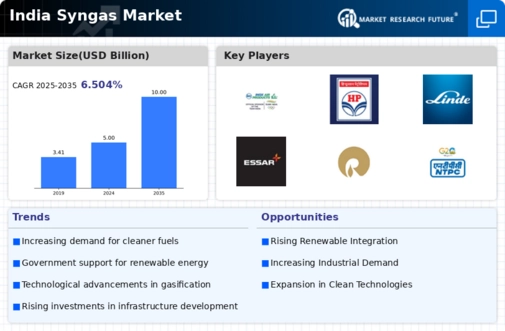The syngas market exhibits a dynamic competitive landscape characterized by rapid technological advancements and a growing emphasis on sustainability. Key players such as Air Products and Chemicals Inc (US), Linde plc (IE), and BASF SE (DE) are strategically positioned to leverage their extensive expertise in gasification technologies and process optimization. Air Products and Chemicals Inc (US) focuses on innovation in hydrogen production, while Linde plc (IE) emphasizes partnerships to enhance its global footprint. BASF SE (DE) is increasingly investing in sustainable solutions, indicating a collective shift towards environmentally friendly practices that shape the competitive environment.
The market structure appears moderately fragmented, with several players vying for market share through localized manufacturing and supply chain optimization. Companies are increasingly localizing their operations to reduce costs and enhance responsiveness to regional demands. This strategy not only strengthens their market presence but also fosters a competitive atmosphere where innovation and efficiency are paramount.
In October 2025, Linde plc (IE) announced a strategic partnership with a leading Indian energy firm to develop a new syngas production facility. This collaboration is expected to enhance Linde's capabilities in the region, allowing for the integration of advanced technologies that improve efficiency and reduce emissions. Such partnerships are crucial as they enable companies to share resources and expertise, thereby accelerating the development of sustainable syngas solutions.
In September 2025, BASF SE (DE) launched a new catalyst technology aimed at improving the efficiency of syngas production processes. This innovation is significant as it not only enhances production yields but also aligns with the growing demand for cleaner energy solutions. The introduction of such technologies reflects BASF's commitment to sustainability and positions the company as a leader in the transition towards greener energy sources.
In August 2025, Air Products and Chemicals Inc (US) expanded its operations in India by investing in a state-of-the-art gasification plant. This facility is designed to utilize waste materials, thereby contributing to a circular economy. The strategic importance of this investment lies in its potential to meet the increasing energy demands while minimizing environmental impact, showcasing Air Products' proactive approach to sustainability.
As of November 2025, the competitive trends in the syngas market are increasingly defined by digitalization, sustainability, and the integration of artificial intelligence. Strategic alliances are becoming more prevalent, allowing companies to pool resources and expertise to tackle complex challenges. The competitive differentiation is likely to evolve from traditional price-based competition towards a focus on innovation, technological advancements, and supply chain reliability, indicating a transformative shift in how companies position themselves in the market.























Leave a Comment